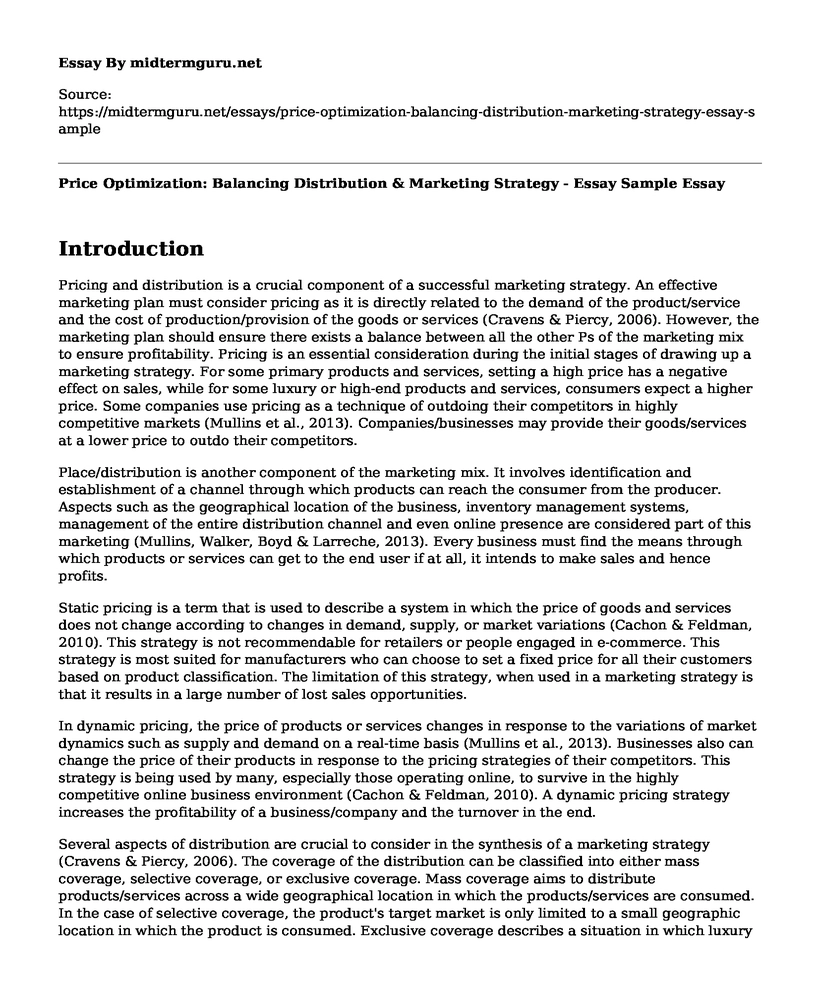Introduction
Pricing and distribution is a crucial component of a successful marketing strategy. An effective marketing plan must consider pricing as it is directly related to the demand of the product/service and the cost of production/provision of the goods or services (Cravens & Piercy, 2006). However, the marketing plan should ensure there exists a balance between all the other Ps of the marketing mix to ensure profitability. Pricing is an essential consideration during the initial stages of drawing up a marketing strategy. For some primary products and services, setting a high price has a negative effect on sales, while for some luxury or high-end products and services, consumers expect a higher price. Some companies use pricing as a technique of outdoing their competitors in highly competitive markets (Mullins et al., 2013). Companies/businesses may provide their goods/services at a lower price to outdo their competitors.
Place/distribution is another component of the marketing mix. It involves identification and establishment of a channel through which products can reach the consumer from the producer. Aspects such as the geographical location of the business, inventory management systems, management of the entire distribution channel and even online presence are considered part of this marketing (Mullins, Walker, Boyd & Larreche, 2013). Every business must find the means through which products or services can get to the end user if at all, it intends to make sales and hence profits.
Static pricing is a term that is used to describe a system in which the price of goods and services does not change according to changes in demand, supply, or market variations (Cachon & Feldman, 2010). This strategy is not recommendable for retailers or people engaged in e-commerce. This strategy is most suited for manufacturers who can choose to set a fixed price for all their customers based on product classification. The limitation of this strategy, when used in a marketing strategy is that it results in a large number of lost sales opportunities.
In dynamic pricing, the price of products or services changes in response to the variations of market dynamics such as supply and demand on a real-time basis (Mullins et al., 2013). Businesses also can change the price of their products in response to the pricing strategies of their competitors. This strategy is being used by many, especially those operating online, to survive in the highly competitive online business environment (Cachon & Feldman, 2010). A dynamic pricing strategy increases the profitability of a business/company and the turnover in the end.
Several aspects of distribution are crucial to consider in the synthesis of a marketing strategy (Cravens & Piercy, 2006). The coverage of the distribution can be classified into either mass coverage, selective coverage, or exclusive coverage. Mass coverage aims to distribute products/services across a wide geographical location in which the products/services are consumed. In the case of selective coverage, the product's target market is only limited to a small geographic location in which the product is consumed. Exclusive coverage describes a situation in which luxury or high-end products are only targeted at an exclusively small share of the market.
The relevance of the above-discussed components of the pricing and distribution category of the marketing strategy is that they all have a direct impact on the profitability and the long-term turnover of a business/company (Mullins et al., 2013). Therefore, it is of utmost importance to ensure that the correct pricing and distribution strategy is integrated into the marketing strategy to ensure the continued expansion of the customer base, total sales, profitability, and overall turnover.
References
Cachon, G. P., & Feldman, P. (2010). Dynamic versus static pricing in the presence of strategic consumers.
Cravens, D. W., & Piercy, N. (2006). Strategic marketing (Vol. 6). New York: McGraw-Hill.
Mullins, J. W., Walker, O. C., Boyd, H. W., & Larreche, J. C. (2013). Marketing management: A strategic decision-making approach. New York: McGraw-Hill.
Cite this page
Price Optimization: Balancing Distribution & Marketing Strategy - Essay Sample. (2023, Jan 14). Retrieved from https://midtermguru.com/essays/price-optimization-balancing-distribution-marketing-strategy-essay-sample
If you are the original author of this essay and no longer wish to have it published on the midtermguru.com website, please click below to request its removal:
- Martha Stewart Living Omni Media - Essay Example
- Essay on Television Show and a Consumer Product
- Company Success: Revolutionizing Goals Through Brand Management & Customer Consideration - Essay Sample
- Jim Beam: Global Brand Expansion Benefits Brand & Customers - Essay Sample
- Bad Leadership, Government and Administration - Case Study
- 3M: Gaining Success Through Key Presentations & More - Essay Sample
- Uniting Communities: United Way's Vision for a Better Future - Essay Sample







